- +91 9435637641 / 7099895338
- moc.yrevocsidivrup@yrevocsidivrup
- Purvi Gallery
- Guest Comment
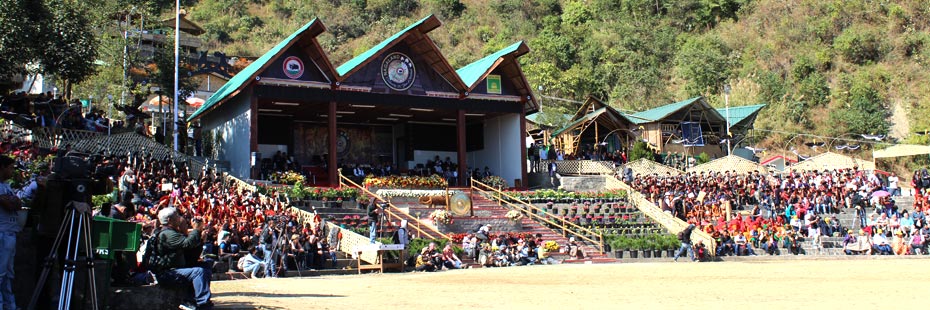
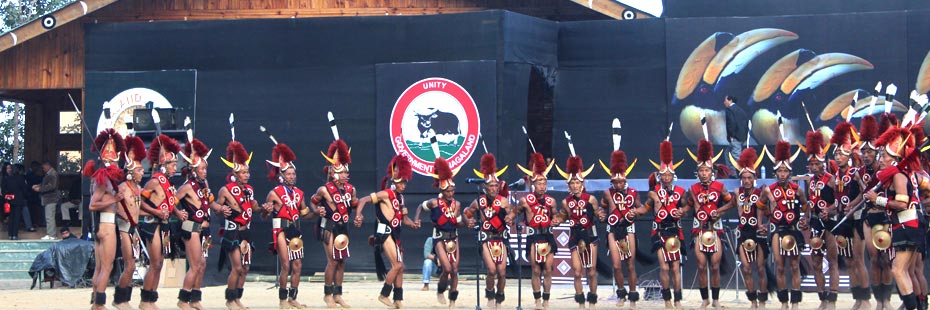
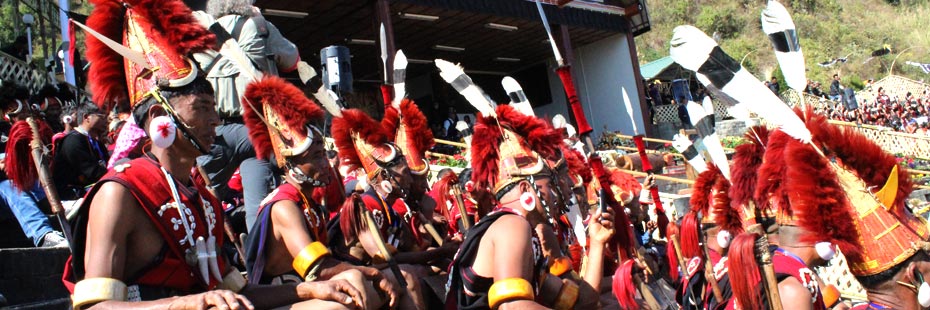
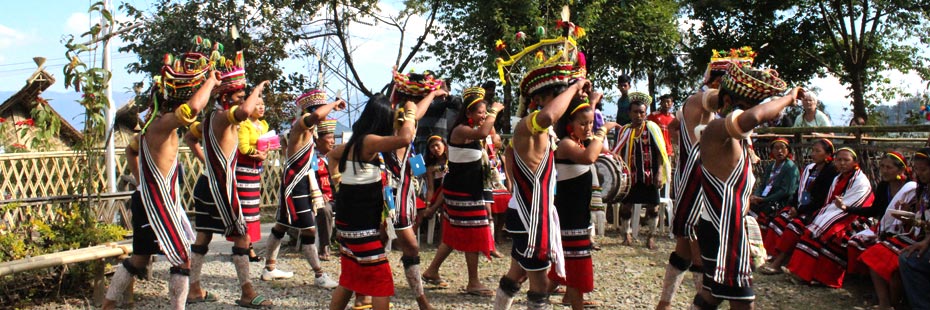
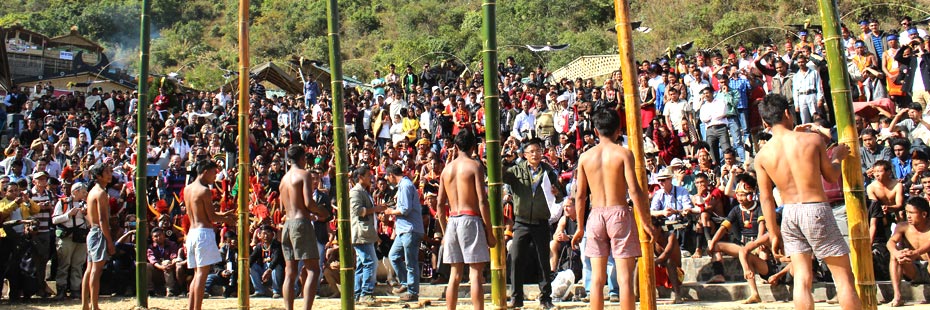
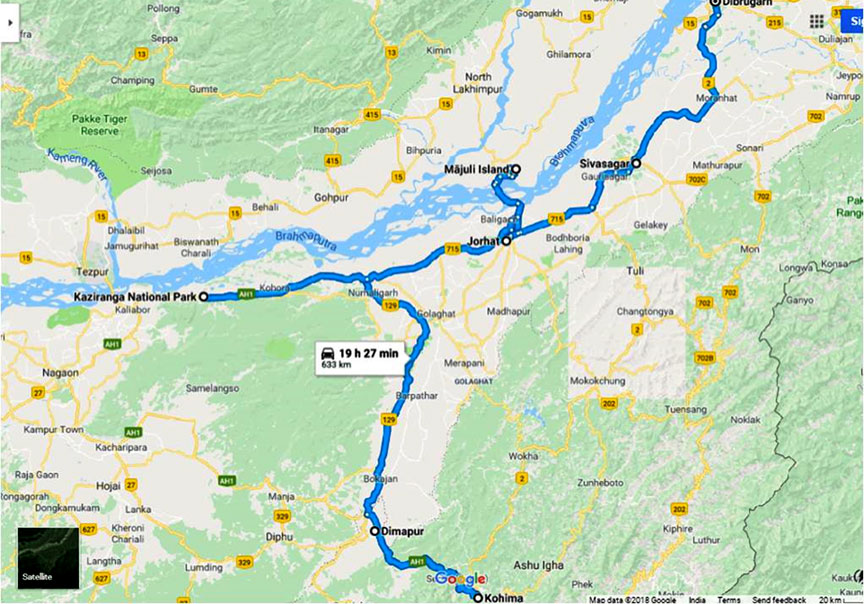
To encourage inter-tribal interaction and to promote cultural heritage of Nagaland, the Government of Nagaland organizes the Hornbill Festival every year in the first week of December from 01-10th December. This colourful festival is organized by the State Tourism and Art & Culture Departments. The Hornbill Festival showcases a mélange of cultural displays under one roof.
It is held at Naga Heritage Village- Kisama which is about 12 kms from Kohima. All the tribes of Nagaland take part in this festival. The aim of the festival is to revive and protect the rich culture of Nagaland and display its extravaganza and traditions. One can witness and understand the people and culture of Nagaland, and an opportunity to experience the food, songs, dances and customs of Nagaland within a single arena. The week-long festival unites one and all in Nagaland and people enjoy the colourful performances, crafts, sports, food fairs, games and ceremonies. Traditional arts which include paintings, wood carvings, and sculptures are also on display. One should consider to be a part of the opening ceremony of the festival held on 01st December, every year.
Received at the Dimapur airport and drive to Kohima (90 kms / 03 hrs). On arrival check in at the hotel for 03 nights. Overnight at the hotel.
Dimapur is the commercial hub of Nagaland. Dimapur, situated on the banks of the Dhansiri River, was once the capital of the Kachari Kingdom. The remains of the broken pieces of stone pillars and other stone carvings can still be seen.
Kohima, situated in the south at an altitude of 1444 m above sea level, occupies pride of place as the capital city of Nagaland. Kohima has the advantage of being centrally located - being bounded by the State of Assam on the west, Wokha district on the north, Zunheboto and Phek districts on the east and the State of Manipur on the south. The Angami, Rengma and Zeliangrong communities mainly inhabit Kohima District.
Post breakfast we drive to the Kisama Heritage Complex (12 kms / 30 mins), for the full day, to observe the different tribal performances and to soak in the atmosphere of the rather colourful and vibrant Hornbill Festival. Enjoy Cultural Dances (All 16 major tribes), War Dances (All 16 major tribes), Folk Songs, Indigenous Games, Music (Rock Beat contest in the evening), Fashion Show (Cultural & Modern), Handloom & Handicrafts, Local Cuisines , Local drinks (Zutho, Thutshe) etc. In the afternoon, have the option to explore the village of the Angami tribe, Jakhama and Kigwema. In the evening, enjoy the Night Bazaar. Overnight at the hotel.
The Jakhama and Kigwema villages are situated on the southern Angami belt and are predominantly inhabited by the Angami tribes which are further divided into several clans. The villages are about 20 kms south to Kohima and are lay out on the top of the mountain with an astonishing natural view of the nearby villages and its surroundings. This entire village is encircled by terraced paddy fields giving it a pleasant look. Each village has got a traditional entrance gate. Within the village one can see the customary Angami houses some of which are elegant and shows the prosperity of the villagers in a traditional way. Here one can explore the village and interact with the local tribes and can be customized with the local life style. “Sekreyni” is the main festival here, which is held in the month of February.
Following breakfast enjoy the Hornbill Festival. In the afternoon, have the option to explore the village of the Angami tribe Khonoma. In the evening, enjoy the Night Bazaar. Overnight at the hotel.
Khonoma Village: Located 20 kms west of Kohima is Khonoma village. The village referred to as “Khwünoria” by the residents is estimated to be around 700 years old and is surrounded by hills that are as high as 9000 ft. It was here that the Naga warriors made their last stand against the British in 1879. The Village is named after a plant locally known as “Khüno” that grows in the area. The alder tree (Alnus Nepalensis) is found in abundance in this region and Khonoma is famous for its management of jhum fields with alder trees, which fixes nitrogen in the soil and checks soil erosion.
With its mission “Green Khonoma”, it has become the Model Village for eco-tourism. The Village Council has made it mandatory for every household to have dustbins. Once in a month, a sanitation drive is carried out and the community’s garbage is burnt. The ashes and the residue are then used as manure. The combination of rich bio-diversity and stunning landscape makes the Khonoma habitat an excellent candidate for eco-tourism.
Post breakfast we again visit the Kisama Heritage Complex to witness another morning of the Festival. In the afternoon we drive to Kaziranga (215 kms / 05-06 hrs) and check in at the hotel for 02 nights.
The Kaziranga National Park is a World Heritage Site, where more than 75% of the world’s total population of the Great Indian One Horned Rhinoceros can be found. It lies on the southern bank of the Brahmaputra River and is one of the oldest parks of Assam. Besides rhinos, the Asiatic Water Buffalo numbering over 1200, elephants over 1000, tigers more than 81, Swamp deer, Barking deer and Hog deer can be seen. About 400 species of birds are found in Kaziranga National Park. Swamp Francolin, Kalij Pheasant, Greylag Goose, Gadwall, Eurasian Wigeon, Mallard, Northern Shoveller, Northern Pintail, Streak Throated Woodpecker, Bay Woodpecker, Oriental Pied Hornbill, Great Hornbill, Osprey, Palas’s Fish Eagle, Changeable Hawk Eagle, Pied Falconets, Lesser Adjutant Stork, Greater Adjutant Stork, Black necked Stork, Grey-headed Lapwing, Indian White Backed Vulture, Long Billed Vulture, along with a large numberof Spotted Billed Pelicans can be seen. Sighting is excellent and is always a great experience. The specialties here are the blue napped pitta among a host of eagles and waterfowl.
We spent the full day exploring the beautiful forests and grasslands of the National Park with morning 01 Elephant Safari (Optional) followed by 01 Jeep Safari post breakfast. Post lunch enjoy another Jeep Safari. Overnight at the hotel.
Approximately 45 mins duration 05.15 PM to 06.15 PM, 06.15 PM to 07.15 PM
Elephant safari for foreign nationals are held only on Kaziranga Range, Kohora (Central Range) Allocation of elephant riding seats and timings are regulated by the forest department, Kaziranga National Park, Government of Assam. The tickets for the same are issued only on the previous evening of the ride after 7:30 PM. subject to availability. It starts very early in the morning and continues for approx 45 minutes. It is the best way to explore the wide variety of wildlife in Kaziranga National Park. The park is covered by elephant grass which is very high and so the view from elephant back is perfect! During the course of the safari one can see herds of Indian Elephants, One-horned Rhinoceros at a very close distance. This proximity to wild animals in Kaziranga National Park makes the trip memorable and thrilling. The elephant safari takes place in the central range of the park and one gets good views of the rhino while traversing through its terrain of swamps and tall grass. It is also great for early morning photography of rhinos in the mist. There are good chances of seeing the Bengal Florican from elephant back.
Jeep Safaris are permitted on pre-defined tourist circuits within Kaziranga National Park-currently at the following four points. Each of these circuits takes about one and half to two and half hours (or even more depending upon interest of the tourists), subject to local range conditions and weather. Jeep Safari may be cancelled / curtailed due to any reason by the Park Authorities without prior notice.
The Central Range passes through the entire habitat spectrum from ox-bow lakes, savannah woodland to swamp forests. It is very good for mammal sightings as well as for birds (Blue-bearded Bee-eater, Great Hornbill, Rufous Woodpecker). While driving along the trail, one can see rows of Indian Roofed and Tent Turtles (Kachuga tecta and Kachuga tentoria). Water Monitors Varanus salvator are sometimes spotted in the beels.
The Eastern Range abounds in water birds such as bar-headed geese, falcated duck, grey-headed lapwing and spot-billed pelican (a colony of 200 pairs of this globally threatened species nesting on the Bombax trees can be found here).
The Western Range has the highest density of rhinos as this part of the park is swampier. It has grassland birds and raptors (swamp francolin, pallas's fish eagle etc.). Smooth Indian Otters (Lutrogale perspicillata) can sometimes be seen fishing in it’s ox-bow lakes.
After breakfast we drive to Neematighat (80 kms / 02 hrs) for a ferry boat crossing (1hr downstream boat cruise - the time taken depends upon the water level of the river) to Majuli - the largest inhabited river island in the world. Majuli is famous for the Vaishnavite Satras or monasteries (Kamalabari Satra, Auniati Satra, Benganti satra, and many more) and its rich culture. It is nestled between the confluence of the Subansiri and the Brahmaputra River.
We visit the monasteries and interact with the tribes on the island. Later in the afternoon, we ferry across to mainland (01 ½ hrs) and check in at the hotel in Jorhat for the night.
Majuli Island - A World Heritage Site, is located in the Brahmaputra River and is the largest inhabited riverine island in the world. The island has long served as a monastic retreat to the Vaishnavite community and is noted for its beautiful rural setting and the traditional Assamese and Mishing tribal architecture.
On arrival, we drive to a monastery, en-route pass through both Assamese and Mishing Villages - the Mishing houses are typified by being built on stilts and their ‘long house’ style of design. At the monastery we receive an orientation tour by one of the monks of the monastic cell and temple. (Please note that you will be expected to remove your shoes when entering the Vaishnavite monasteries). These Satras/ monasteries were set up by Srimanta Shankardev, the leader of the Vaishnavite revival in the 16th Century. These are active cultural hubs and nurture the traditional dance form ‘Satriya’ (which is the 5th nationally recognized dance form other than Bharatnatyam, Kathak, Kathakali and Manipuri), music and crafts (mask- making), besides religious teachings.
The Mishings belong to the Tibeto-Burman clan of the Mongoloid race. It's not known exactly where they migrated from, but it is believed that they were dwellers of the hills of present day Arunachal Pradesh. This explains the cultural and linguistic similarities they have with the people of the Adi (erstwhile Abor) tribe, and to some extent of the Hill Miri and Dafla tribes of Arunachal Pradesh. Somewhere around the 13th century, they started migrating towards the plains of Assam, most probably in search of fertile land. This exodus continued for at least 2-3 centuries.
As fate would have it, they found one of the most fertile river-beds (that of the mighty Brahmaputra) and settled on both banks along the length of the river, starting right from Sadiya in the east, to Jorhat in the west. They continued their practice of living in thatched houses raised on bamboo stilts, known as Chang ghar. It was a protection against flood waters during the rainy season, although the original logic behind raised houses was protection from wild beasts.
The yearly floods ensured that the Mishings lived a life of abject poverty and misery. Agriculture being their main occupation, floods affect them in more ways than one.
Their chief festival is Ali-Aye-Ligang, in the month of February, which celebrates the agricultural harvest. Most Mishings follow both the Donyi-Polo and Hindu religions, and there are a few Christians who follow the Catholic or Baptist faith. The language of the Mishing people is also known as Mishing language.
After breakfast we drive to Dibrugarh (140 kms/ 03 ½ hrs). Enroute we visit the Ahom monuments and temples at Sivasagar which encompass the 600 year old history of the Ahom Dynasty. On arrival check in at hotel. In the evening enjoy a dance performance by an ethnic dance group at the Mancotta Heritage Chang Bungalow. Overnight at the hotel.
Sivasagar was once the capital of the Ahom Kings. The Shans who came from Thailand through Northern Myanmar to this area in early 13th century, ruled for 600 years. The Siva Temple, built by the Ahoms, situated here is believed to be the tallest of all existing Hindu temples. The ruins of the Ahom palaces and monuments dot the landscape around this historical town. Centuries, before the arrival of the British, this part of the world was controlled by a number of tribal chieftains.
In the town of Sivasagar, one can still see the remaining well preserved relics. The largest and the oldest amphitheatre of Asia (Rang Ghar) is also another remarkable landmark in the history of Sivasagar. The Tai - Ahom Museum of Sivasagar contains some of the relics of the Ahom period like - swords, clothes, manuscripts and sundry artifacts.
Dibrugarh is the gateway to the “Hidden Land” of Eastern Arunachal Pradesh and Northern Myanmar. The Ahoms from Thailand came through Northern Myanmar to this area in the 13th century to establish their Empire which thrived in the ancient land of Assam. It is the “Camellia” town of Upper Assam, an undisturbed haven, with its rich tea gardens resembling a lush green carpet. Experience and enjoy the richness of these tea gardens while staying at the Heritage Chang Bungalows. These are constructed on stilts and are situated in a serene atmosphere free from pollution.
When the British established their tea plantations in the mid-19th century they quickly built comfortable bungalows designed to make life as pleasant as possible in what, was to them, a hostile and strange land. One of the main features of these buildings has given rise to their name - Chang Bungalows. Chang in the local language means “raised on stilts” and the design served multi purposes- to keep the house cool by allowing the breeze to blow underneath and to keep both water and animals out!
Bihu is the most popular folk dance of Assam. The people of Assam are very proud of its unique position among all other such dances of India. Perhaps except Bhangra (the popular folk dance of Punjab), no other folk dance in India can compete with the rhythmic exuberance of the Bihu dance. ‘Bihu’ performed by young men and women reflects youthful passion and joy rejuvenating life during the spring season, accompanied by songs woven around the theme of love and physical yearning. The dance is performed by all- irrespective of caste, creed and religion.
Post breakfast, take a tea tour around a tea estate known for producing high quality CTC tea - Ethelwold Tea Estate. Also experience a tea tasting session of different types of tea with a knowledgeable person in the field of tea / practicing estate manager, followed by visit to Mukul TE which specializes in organic green tea. Later drive to Tinsukia (01 ½ hrs).
In the afternoon, witness the Tea Festival, a celebration of and by the people of the tea tribal communities of Upper Assam. Enjoy the vibrancy of colour, traditional dance and art forms, folk music and a variety ethnic food and handicrafts. Experience the exuberance of festivity with the people of the tea gardens of Assam. Drive back to Dibrugarh. Overnight at hotel.
A Tea Tour through a 160 years old heritage tea garden will give you an insight into the different activities that vary from season to season. It will teach you all about tea- its origin, how it is grown, tea tasting and its quality. The estates come alive with teams of colourfully dressed tea pluckers, predominantly ladies, who pluck the delicate buds and leaves. The harvest is taken every day to the factory where it undergoes an age old process of being turned into the finished product. All stages of the process are carefully controlled to ensure that the product which leaves the factory is only of the highest quality, a quality that has made Assam tea world famous.
CTC (Crush, Tear and Curl) tea is a method of processing tea. In this process the leaves instead of being rolled, are passed through a series of cylindrical rollers with hundreds of small sharp "teeth" that Crush, Tear, and Curl.This style of manufacture has the advantage that the finished product brews quickly, gives a dark infusion rapidly, is well suited for tea bags, and yields more cups per kg. In the Indian domestic market, this product has virtually taken over - over 80% of the tea produced is of the CTC type. It produces a rich red-brown color when the tea leaves are boiled and so is best suited for tea made in the Indian style. This is done by boiling leaves in a mixture of milk, water and sugar and some spices (producing Masala Chai).
Note: Visit to tea factories is subject to being operational on the day of the visit. There is no tea plucking between December and mid-March and hence the actual manufacturing processing of tea cannot be demonstrated when one visits the factory during this period. Factory also remains closed on Monday’s of the week.
Mukul Tea Estate has an area of 27 hectares and is about 8 Kms (approx 30mins) away from Mancotta Heritage Chang Bungalow. The entire garden which is organic, is located within pristine surroundings. The estate, has within its boundary, a tea plantation, a rich bamboo stand and a wet land which attracts numerous bird species. Visitors can enjoy a firsthand experience of plucking tea by hand and preparing roasted green tea themselves.
“The Tea Festival” is organized by the tribal communities of the tea estates and is their endeavour to showcase the diversity and the richness of culture that exists among them. It is a rather colourful celebration of tradition, art and culture, and is a unique festival that offers an opportunity to witness the multiplicity of dance forms, musical performances, instrumental collaborations, and handicraft displays, found among the tribal communities of the tea growing areas of Upper Assam.
Later in time transfer to Dibrugarh airport to board flight for onward destination.
Our package rate for the above itinerary (08 Nights / 09 Days) on full board basis valid until 10 Dec 2018
Rs. 88000.00 per pax on twin sharing
Single room supplement: Rs. 28000.00 per pax